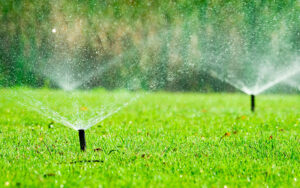 Winterizing your sprinkler system may not come to mind when we think of the cold months in Dallas, TX. But even mild winters can cause serious damage if you’re not careful. That water sitting in your sprinkler pipes can freeze and cause all sorts of headaches, including cracked pipes, busted valves, and repairs that’ll make your wallet cry.
Winterizing your sprinkler system may not come to mind when we think of the cold months in Dallas, TX. But even mild winters can cause serious damage if you’re not careful. That water sitting in your sprinkler pipes can freeze and cause all sorts of headaches, including cracked pipes, busted valves, and repairs that’ll make your wallet cry.
But fear not! We’re walking you through how to winterize your sprinkler system effectively and keep it happy during the chilly months.
Understanding Your Sprinkler System in Dallas
Types of Irrigation Systems
The first step in winterizing is to understand the type of irrigation system you have. Systems can vary in design, size, and components, and each type requires a slightly different approach.
Whether you have a drip irrigation system, spray system, or rotor system, knowing the specifics will help you decide if you should handle the winterization process yourself or hire a pro. If your system is complicated or if you’re unsure, it might be best to consult an expert.
Seeking Professional Help
Speaking of pros, if you do decide to get some help, make sure you’re choosing the right professional. Look for companies with proper accreditations, warranties, licensing, and insurance. These factors indicate expertise and accountability.
Some companies even offer year-round packages that include sprinkler winterization. Lawn Sense, for example, has been a trusted provider in Dallas and nearby areas, helping homeowners maintain their lawns throughout the year.
Steps to Winterize Your Sprinkler System
Now, let’s get down to business. Here’s what you need to do:
1. Inspect the System
Begin by checking your sprinkler system thoroughly. Look for any signs of damage or leaks in spray heads, pipes, and other components. Address any issues before moving forward with winterization to avoid further damage.
2. Turn Off the Water Supply
After inspection, shut off the water supply at the main valve. This step prevents water from hanging around in the pipes, which could freeze and cause them to burst.
If your system includes a stop-and-waste valve, make sure it’s positioned to drain any remaining water. Also, drain and shut off the backflow device valves to protect them from freezing.
3. Turn Off the Timer
Next, adjust the sprinkler system’s timer. You can either shut it off completely or set it to rain mode, which prevents the system from running during the winter.
Also, check the timer’s battery backup to confirm it’s functioning properly, preserving your settings for when the system is restarted.
4. Drain the Water
Draining the water from your system is one of the most critical steps. There are three methods to do this: manual draining, automatic draining, and the blowout method.
- Manual Draining: Open valves at the low points or pipe ends to let water drain out. This method is straightforward but requires a bit of work.
- Automatic Draining: Some systems have automatic drain valves that activate when water pressure drops, allowing water to exit the pipes. This is a convenient option, though it requires familiarity with your system.
- Blowout Method: Using an air compressor to blow water out of the system is highly effective, but you must do it carefully to avoid damage. If you’re inexperienced with this method, it may be safer to call in a professional.
5. Wrap up Exposed Components
Finally, wrap up any exposed parts of your sprinkler system, such as the main shut-off valve, exposed pipes, and backflow preventers. Think of it like tucking your sprinkler system in for a long winter’s nap.
So, use insulation tape or straw to cover these areas, providing protection against freezing.
How to Protect Outside Faucets and Hoses
Shut Down the Outside Faucets
Outside faucets need attention as well. Turn off the water supply and drain any remaining water to prevent freezing.
If your faucets lack an interior shut-off valve, consider using insulation or faucet covers for added protection.
Disconnect the Hoses
Disconnect garden hoses from faucets, drain them, and store them properly. This prevents water from freezing inside the hose, sparing the hose from cracking and reducing its lifespan.
How Much It Cost to Winterize Your Sprinkler System
The average cost to winterize a sprinkler system is around $90, though prices vary depending on yard size and the number of zones.
- Manual Drain: Costs range from $65 to $150.
- Automatic Drain: Prices typically fall between $75 and $165.
- Blowout Method: This is the most expensive option, ranging from $85 to $235, with additional rental costs if you do it yourself.
Consider getting a few quotes to find the best deal for your needs.
Why Choosing Lawn Sense to Winterize Your Sprinkler in Dallas
Winterizing your sprinkler system is a key step in maintaining its longevity and functionality. Although DIY can be tempting, it might be worth calling in the pros if you’re not sure what you’re doing, especially with that blowout method. A small mistake could lead to some expensive repairs down the line.
Lawn Sense is here to help you make sense of your lawn. We have the experience and tools needed to winterize your sprinkler and keep your lawn and irrigation system in top shape throughout the year. Don’t leave your sprinkler system vulnerable this winter. Take the necessary steps to safeguard it now. Give us a call!